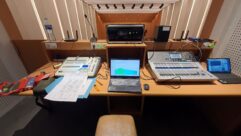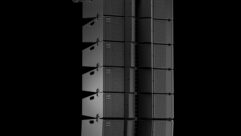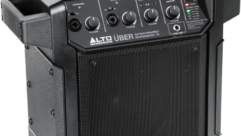
Anchor Audio Beacon Portable Line Array Sound System Review
Oct 18, 2012 2:46 PM, Reviewer: John McJunkin
A system clearly meant for voice reinforcement as a primary application.
It seems that portable PA solutions invariably involve a small mixer, a pair of speakers-on-a-stick, and a couple of amplifiers to power the speakers. If a higher degree of sophistication is needed, wireless mics may be added to the kit as well, along with a CD, iPod, or some other small playback device. Suddenly not only does the “simple PA” have a dozen or more pieces and requires several AC power points, it also now requires a time-consuming setup—speaker cable runs, input and output connections, and power supplies. What if AC isn’t available? What would the solution be? It would look like Anchor Audio’s Beacon portable line-array sound system.
Completely self-contained, the system can be powered by AC or two rechargeable 12V 9.0-amp-hour batteries that provide six to eight hours of continuous music at medium levels and two to four hours at higher levels, with even longer life if used exclusively for speech. Recharged by simply plugging the system into AC power, the batteries are user-replaceable, which Anchor Audio recommends every two to three years. The system also offers a line array speaker column atop a subwoofer base, while the upper-frequency column folds in half and can be stowed inside the base, which contains lower-frequency drivers, amplifiers, the system’s mixer, among other things. The base, which is 51lbs., has a pair of wheels that allows for easy transport of the system.
Upon arrival at your destination, the speaker column is extracted from the base and then inverted where its fits into the opening from which it was removed. It’s foolproof in that it will only drop into place one way. The latches that held the column in place in the base are then clamped down once again to lock and secure it. Not only are the latches important for structural integrity, but they also provide the electrical connection that delivers the signal to the speakers inside the column. Once the latches are re-clamped, the column is unfolded—that is, at the lower section, the two halves are pulled apart, revealing that the column is hinged at the top. The upper half swings up into position atop the lower half. This action brings together two attachments that are similar to the contacts on top of standard 9V batteries, albeit larger and vastly more robust, so that they firmly hold the top half of the column in place and convey the electrical signal from the lower half to the upper half.
At this point, the system is ready to go, and either AC or internal battery power can be applied. The rear panel of the system features all of its controls, input/output connectors, and a handful of indicators to show system status. Starting at the bottom, there is an IEC power inlet and main power switch, a power-status LED, and a four-segment LED meter indicating battery-charging status. Above this is a nifty and unique feature: DC and USB power outlets. There have been numerous occasions when I’ve had an USB device that needed a charge or even continuous power, and had no way to provide either. This output is welcome, as is the DC outlet, which provides 5V at 500m—an arbitrary figure, but useful for many small devices.
Above these power outlets, we get into the audio I/O and controls. A column of knobs on the right control input levels for two wired mics plugged into the system, bass and treble shelving levels, and the level of the system’s line input or MP3 player. A pushbutton near the bottom of this column of knobs toggles “voiceover,” which ducks music level by 12dB for speech. To the immediate left of the knobs are two XLR mic inputs, stereo RCA and 1/4in. balanced line-level outputs, stereo RCA, and 1/4in. balanced and 1/8in. in stereo line-level inputs. To the left of these connectors are knobs that control level and determine the frequency for each of the system’s two integrated wireless receivers. Finally, at the top of the rear panel is an integrated MP3 player, with pushbutton controls that facilitate navigation through the file and folder structure of an attached USB device, or the SD card that can be inserted directly into the front of the player. An LCD display provides feedback for that navigation, and an additional 1/8in. auxiliary in jack is also featured on the front panel. This is another of the system’s unique and useful features. It’s truly a pleasure to be able to roll up, set up, power up, and be ready to provide whatever prerecorded material is necessary—all without a separate playback system.
The line array column contains eight 4in. high-frequency drivers, and the subwoofer base contains three 8in. low-frequency drivers. Amplification is entirely internal and totals 150W for the full frequency spectrum. The LF cabinet is not a traditional speaker enclosure per se, and its lightweight, but sturdy plastic is not optimal for LF enclosure construction. Nevertheless, the three drivers and associated amplifier deliver reasonable bass, but it does not shake the ground by any stretch of the imagination. The highs are clear and reasonably accurate, and provide plenty of the frequencies associated with clarity in human speech. I detected a bit of distortion in the lows and midrange at high SPLs, but otherwise, the overall delivery is adequate. I would characterize the fidelity of the system as passable for music and excellent for voice, and that’s fine—it’s a system that is clearly meant for voice reinforcement as a primary application. A more traditional system is probably a better choice if high-fidelity music is required. That said, this system is truly excellent for voice reinforcement.
The two wired mic inputs and the two wireless mic channels deliver a lot of gain to the amplifiers, resulting in very loud, very clear voice reinforcement. The throw of this system in an outdoor setting is considerable; I could hear it clearly several hundred feet away. Bear in mind that this is strictly the case for voice only; music would be significantly distorted if it were brought up to a level that would project that distance. But for voice, the system is truly amazing, particularly considering that it’s battery-powered, and when used exclusively for voice, should yield several hours of operation, even at substantial SPLs. The system exhibits a moderate amount of self-noise, but not so much as to distract, and again, it’s not intended to be a high-fidelity music-oriented PA system.
This system is very useful, with a clever portability scheme, and delivers excellent speech fidelity at substantial SPL. I would not recommend it for applications in which music is the primary focus unless a remote location absolutely requires a battery-operated system, in which case the priority of portability outweighs that of high fidelity, and makes the system attractive. The system is very lightweight and easily transported and set up, considering the astonishing SPL for voice reinforcement. It also features a handy soft pouch on one side of the main enclosure for storage of papers, knick-knacks, SD cards with audio necessary for the application, and so on. I’m truly impressed with the system, and I would definitely recommend it to anyone who needs a solid, completely portable voice reinforcement system with the capacity for light music duty.
PRODUCT SUMMARY
Pros: Light, easily moved and set up, substantial SPL for voice reinforcement
Cons: System fidelity not as high for music as for voice
Applications: Portable voice reinforcement/light music duty for indoor or outdoor uses
Price: $2,428.99
SPECIFICATIONS
Rated Power Output: 150W AC / 125W DC
Max SPL @ Rated Power: 112dB
Battery: Two 12V rechargeable, 9.0 AH Full recharge: approx 7 hrs
Frequency Response: 60Hz – 15kHz ± 3dB
Line Output (post fader): Isolated, 600Ω, 1/4in. phone
AC Power Requirements: 100 – 240 VAC, 50/60Hz, 300W max
DC Out: 12V 500mA
USB: 5V 500mA
Dimensions (HWD): 26.25”x11”x18” (66.7 x 28 x 45.7cm)
Weight: 51lbs./23Kg
Mic Inputs: Lo-Z (1KΩ), balanced, XLR 12VDC condenser (phantom)
Line Inputs: Hi-Z (10KΩ), unbalanced; 1/4in. phone; Hi-Z (10 KΩ), unbalanced; 1/8in. stereo; stereo RCA
Line Output: 1/4in. phone unbalanced; stereo RCA
Sensitivity For Rated Output
Lo-Z Microphone: -52dBV (2.5 mVrms)
Hi-Z Microphone: -43dBV (7.5 mVrms)
Auxiliary (line): -14 dBV (200 mVrms)
Phantom Power: 36V
John McJunkin is the principal of Avalon Podcasting in Chandler, Ariz., and produces and co-hosts a top-rated morning radio talk show in Phoenix. He has consulted in the development of studios and installations and provides high-quality podcast and voice production services.










